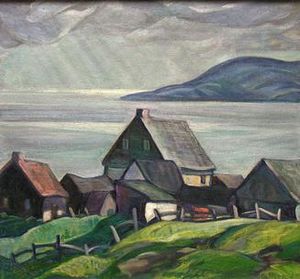Nora Collyer facts for kids
Nora Frances Elizabeth Collyer (June 7, 1898 – June 11, 1979) was a Canadian painter. She was known for her modern style. Nora loved to paint the beautiful Canadian landscape, nature, and city scenes.
Nora was an artist and a teacher. She learned art at the Art Association of Montreal (AAM). There, she studied with famous teachers like Alberta Cleland, William Brymner, and Maurice Cullen. Nora Collyer was the youngest of ten women artists who formed the Beaver Hall Group.
Besides her art and teaching, she also volunteered at the Children's Memorial Hospital in Montreal. Her paintings were shown at big events. These included the British Empire Exhibition in England in 1924 and 1925. Her art was also displayed at the 1939 New York World's Fair.
Contents
Early Life and Art School
Nora Collyer was born in Montreal, Quebec, on June 7, 1898. Her family moved to Westmount, a part of Montreal, when she was young. She was an only child until she was twelve.
From 1910 to 1917, Nora went to Trafalgar School for Girls. She was a shy person, so she liked the small classes there. She made two lifelong friends, Margaret Taylor and Jane Speir, at this school.
Nora Collyer, along with other artists like Anne Savage and Sarah Robertson, got most of their art training at the Art Association of Montreal (AAM). Nora studied there for nine years. Her teachers, especially William Brymner, taught her to express herself. This idea became very important in her art.
Joining the Beaver Hall Group
Nora Collyer became part of the Beaver Hall Group in Montreal in 1920. This group was a special club for artists. A. Y. Jackson, a co-founder, was also part of the famous Group of Seven. He told the women artists to be bold and paint in new ways. He encouraged them to ignore old ideas about what women artists should paint. Nora and her friends followed this advice. They broke away from old traditions in art.
The Beaver Hall Group's Impact
The Beaver Hall Group was a very important art group in Canada. Even though the group only lasted about a year and a half, the friendships they made lasted for decades. The group held four art shows during its short time. They also had at least one other show in their own "club rooms" in 1920.
Nora Collyer left the Art Association of Montreal in May 1921. Later, she shared an art studio with her friend Anne Savage. By 1924, the artists found it hard to pay for their studios. However, the women artists, including Nora, formed a strong network. This network grew to include other artists like Prudence Heward and Kathleen Morris. They supported each other in their art.
Nora's Painting Style
Nora Collyer's art was known for its interesting shapes, bright colors, and smooth flow. She often went on sketching trips as a student. These trips helped her develop a balanced and rhythmic painting style.
Her paintings rarely showed people. Instead, she loved to paint flowers, forests, rivers, and old buildings. She also painted villages and churches, like in her work Afternoon, the Village of Cap-à-l'Aigle Overlooking the St. Lawrence River, 1950. Nora was aware of social issues and volunteered at hospitals. However, she did not show these problems in her paintings. Her art focused on beautiful scenes, such as Mount Royal or the old Martello Towers in Quebec.
Anne Savage, a fellow artist, said Nora's work had a "freshness and vitality." This meant her paintings showed a lively feeling for both country and city life. Nora carefully planned her pictures. She often used diagonal lines from trees, triangular shapes of land, and horizontal bands of colors. She also made buildings, like a church or a barn, the main focus of her art. An example is her painting Village Church In Summer.
Teaching Art to Others
Nora Collyer started her teaching career in September 1925. She became an art teacher at Trafalgar School, where she used to be a student. She earned $800 a year.
Her teaching stopped for a while in 1930 when her mother passed away. Nora felt she needed to go home and take care of her father and brother. Her mother had volunteered a lot for the Anglican Church. Inspired by this, Nora began teaching art at the Children's Memorial Hospital. She also taught at other places.
After her father died in 1946, Nora became an even more active teacher. She started art classes for children and adults in her own home. Kathleen Morris's niece, Susan Kilburn, took one of Nora's children's classes. Later, she took private lessons from Nora. Nora liked to set up a still life for her students to paint. This helped her show them how to use contrast in their art.
Later Years and Legacy
Nora Collyer stayed friends with her old schoolmates. Her closest friend was Margaret Reid. After her father died, Nora moved into an apartment. Margaret Reid later joined her there.
In 1950, the two women bought land near Lake Memphremagog. They built a summer cottage there and called it Strawberry Hill. Nora spent her summers sketching and gardening at the cottage. Margaret would visit on weekends. They owned this cottage until 1967.
In 1953, Nora and Margaret moved into a duplex in Westmount. Nora used her sitting room to teach art. Margaret Reid later developed Alzheimer's disease. Nora took care of her for as long as she could. Sadly, Nora Collyer passed away on June 11, 1979. This was just twelve days after her dear friend Margaret.
Nora Collyer's art has been honored with several special shows. These shows, called retrospectives, celebrate her work. They include:
- Dominion Gallery, Montreal (1946)
- Walter Klinkhoff Gallery, Montreal (1964)
- National Gallery of Canada, Ottawa (1969)
- Paul Kastel Gallery, Montreal (1971)
- Galerie Continentale, Montreal (1981)
Images for kids



